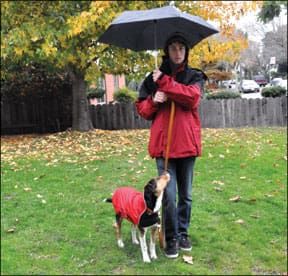[Updated July 6, 2018]
Nasty, cold, blowing, snowing, sleeting, rainy day out and your dog won’t go out to potty? I can relate; I don’t much like to go out in bad weather either – even if I don’t have to poop and pee out there. Help is on the way. Here are five things you can do to help improve your dog’s winter “eliminate outside” outlook:
1. Go out with her.
She may be much more willing to brave the elements if her beloved human is with her. If you go with her you can keep her mind on her business, use her potty cue, get her to eliminate more quickly, and you will know if she’s empty or not. Don’t whine; if she has to go out, you can go out too!
2. Condition her to wear a coat and boots.
Watch this excellent video of Jean Donaldson conditioning her Chow, Buffy, to wear a head halter. Then use the same procedure with your dog’s coat and boots.
If she’s a short-coated, easily frozen kind of dog (think Chihuahua), you can hardly blame her for not wanting to go out on those wet, windy, or freezing days. When she’s happy to wear a coat, select the appropriate one for her from her ample wardrobe – a sweater for cool, blustery, fall days; a raincoat for wet ones; and a comfy down vest over the sweater for the days with real hypothermia potential.
3. Carry a large umbrella.
A big golf umbrella can completely protect a small-to-medium-sized dog from rain and snow, and partially protect a large one. While your thick-coated Great Pyrenees and water-resistant Labradors ought to be able to tolerate a little inclement weather, your thin-coated Great Dane might object. Remember to condition your dog to love your umbrella before you actually use it for weather purposes.
4. Build a covered potty area outside, and shovel a path to it.
Your dog will be happier to do her stuff outside if she has a spot that’s sheltered from wind and blowing snow or rain. Make it as close to the house as possible, so she doesn’t have to go far to get to it, and you don’t have to shovel as much snow. Be sure to build the shelter tall enough that you can stand under it, too!
5. Teach her to use an indoor litter box.
See “Indoor and Patio Litter Boxes for Home-Alone Dogs,” for directions on teaching your dog to use a litter box. Or at least put a litter box in your garage, or on your covered porch. The cold-aversive part of me thinks this is the best solution of all. If your dog has been really well trained not to go indoors you may need to start with teaching her to use her litter box outside, and when she’ll use it there, bring it indoors. At least you can do the training on warm sunny days, and use one or more of the other options to protect her outside on nasty days, until you’re ready to move the box indoors.
Purina makes small litter boxes and “secondnature,” a litter especially for dogs (although many dog owners use cat litter in their dog litter boxes). Some pet owners find puppy “pee pads” to be an adequate replacement for a litter box. But there are also a number of products on the market that simulate a bit of lawn for your dog’s indoor elimination. The “Porch Potty” is a box that accommodates the use of either real or artificial grass turf and contain any liquid runoff. The Ugodog is a similar system that employs the use of a mesh grating instead of a grass or grass-like surface for the dog to eliminate on. These products are fairly expensive, but may be just the thing for your fair-weather dog. Happy winter. Stay warm!
Pat Miller, CPDT, is Whole Dog Journal‘s Training Editor. Miller lives in Fairplay, Maryland, site of her Peaceable Paws training center. Pat is also author of The Power of Positive Dog Training; Positive Perspectives: Love Your Dog, Train Your Dog; Positive Perspectives II: Know Your Dog, Train Your Dog; and Play with Your Dog.





